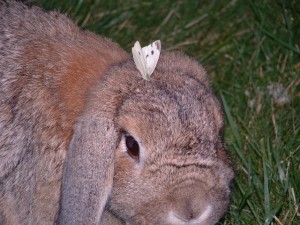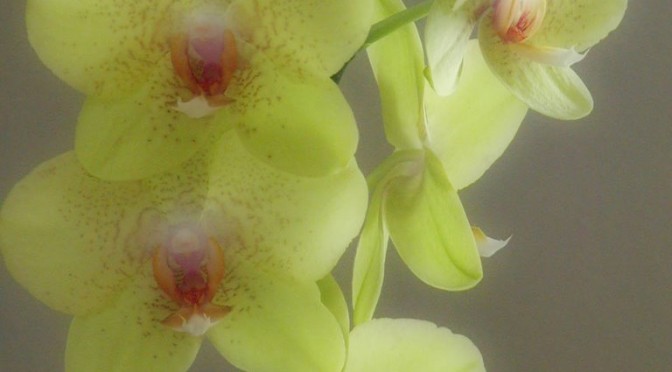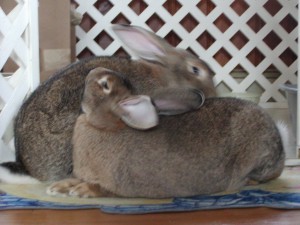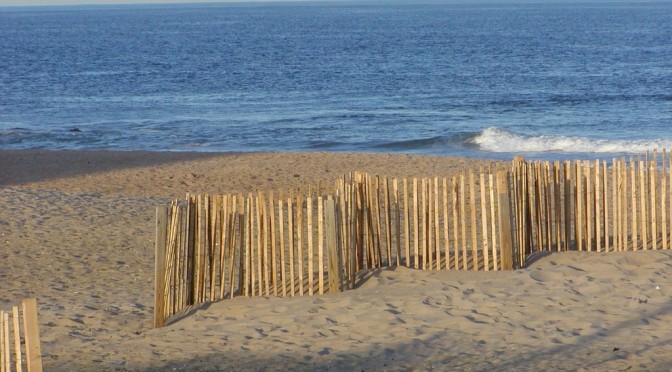Monthly Archives: April 2006
My brothers and me, again
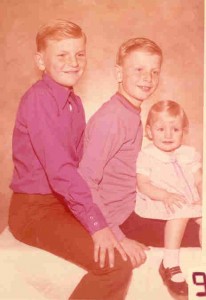 Among the many photos that my mother kept secreted away in the china cabinet drawers was this, one of a set that was taken by a professional photographer when we were kids. My mother never had them printed, so all we have are the numbered proofs with this funny purplish cast. Considering that the photos were taken in the early seventies, my brothers may just have been wearing purple shirts, who knows!
Among the many photos that my mother kept secreted away in the china cabinet drawers was this, one of a set that was taken by a professional photographer when we were kids. My mother never had them printed, so all we have are the numbered proofs with this funny purplish cast. Considering that the photos were taken in the early seventies, my brothers may just have been wearing purple shirts, who knows!
I’ve always liked this photo and would love to someday have it retaken, with us in the same pose, as grown-ups. We wouldn’t be as handsome or as sweet-looking, but the sentiment would be the same.
Phalaenopsis “Brother Digger”
 If you are not killing plants, you are not really stretching yourself as a gardener. – J.C. Raulston
If you are not killing plants, you are not really stretching yourself as a gardener. – J.C. Raulston
The orchid I bought a few weeks ago is still alive and blooming beautifully. I haven’t killed it yet. I took this photo today so that I have something to remember it by when it dies. I’m stretching myself, but fear orchids are out of my league.
Osprey ingenuity
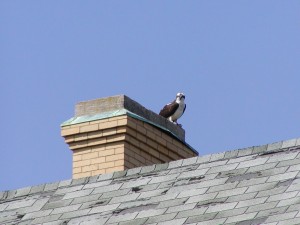 Aside from Red-tailed hawks, I think Osprey must be the most cosmopolitan of nesting raptors in these parts. So long as there is water within a reasonable distance and a suitable structure on which to build a nest; they will do so.
Aside from Red-tailed hawks, I think Osprey must be the most cosmopolitan of nesting raptors in these parts. So long as there is water within a reasonable distance and a suitable structure on which to build a nest; they will do so.
This photo was taken last week at Sandy Hook, where there are multiple pairs of nesting Osprey. Most pairs there nest on man-made platforms on the salt marsh, but a few, like this one, nest in the chimneys of the building on officer’s row overlooking the bay. They are quite used to pedestrians below their nest, but were agitated when I stopped to take photos.
In the town where I live, Osprey have nested for the past few years on a cell tower overlooking the railroad tracks and a lumber yard. The nest is huge and I’m delighted to see the pair when I stop for gas on my way to work in the morning. Often, at home, I will see them coming and going high above my yard.
In South Jersey, Osprey build their nests on channel markers, close to the water’s su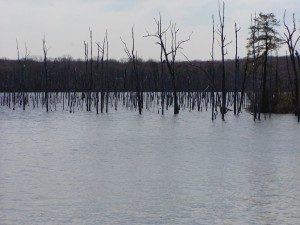 rface. There is a pair with a “natural” nest in the photo at right, very close to the water level at the reservoir where this photo was taken today. The park naturalist told me that the reservoir is at 97% capacity now and if that were to increase, their nest would be flooded. My husband and I visited the Manasquan Reservoir Environmental Center today while out looking for ponding supplies. The center has lots of great displays, but the biggest draw for my husband are the Bald Eagles. They’ve nested here for a few years and are easy to see. My husband commandeered the binoculars today while I was taking photos and had a nice look at an Eagle being harassed by two Osprey. Sadly, the nest has failed again this year as the eggs didn’t hatch. Last year, the female of the pair died during egg-laying, so I guess it’s not a surprise that this pair with a new female would not be successful at their first attempt. This is one of maybe 3 or 4 nesting pairs in my county so I’m very concerned (and thrilled!) with them. I hope they will get it right next season.
rface. There is a pair with a “natural” nest in the photo at right, very close to the water level at the reservoir where this photo was taken today. The park naturalist told me that the reservoir is at 97% capacity now and if that were to increase, their nest would be flooded. My husband and I visited the Manasquan Reservoir Environmental Center today while out looking for ponding supplies. The center has lots of great displays, but the biggest draw for my husband are the Bald Eagles. They’ve nested here for a few years and are easy to see. My husband commandeered the binoculars today while I was taking photos and had a nice look at an Eagle being harassed by two Osprey. Sadly, the nest has failed again this year as the eggs didn’t hatch. Last year, the female of the pair died during egg-laying, so I guess it’s not a surprise that this pair with a new female would not be successful at their first attempt. This is one of maybe 3 or 4 nesting pairs in my county so I’m very concerned (and thrilled!) with them. I hope they will get it right next season.
The environmental center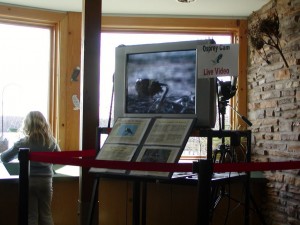 has an *Osprey Cam* so that visitors can have a close-up view of the pair. I wonder if there are eggs yet based on this birds posture on the nest. They’ve only been back for a 2 or 3 weeks now, but considering all the activity *ahem* I saw out at Sandy Hook last week, Osprey don’t waste any time before they start breeding.
has an *Osprey Cam* so that visitors can have a close-up view of the pair. I wonder if there are eggs yet based on this birds posture on the nest. They’ve only been back for a 2 or 3 weeks now, but considering all the activity *ahem* I saw out at Sandy Hook last week, Osprey don’t waste any time before they start breeding.
Trees
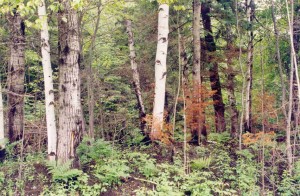
The following is a small part of a literary translation project I completed while an undergraduate Spanish major. The author is Ana Maria Matute and this essay was published in 1973 as part of her book, El rio (The River).
Ever since I was a young child I have been drawn to trees. I always knew their names, but for a long time I gave them names of my own that I can still remember. The trees in a forest are obviously different from one another, like people, once you have spent time with them. There are things that exist among the trees that cannot be found anywhere else. Nothing is the same as their shade, their silence, their quiet life. The beech trees, the oaks, the white and black poplars. And each one of them has an expression distinct from the others of its kind. I remeber the afternoons, the mornings, the sunset with the light disappearing among the trunks. That intense and silent life, stretched across the land, facing the sky. You are never totally alone among the trees. The wind, the swaying branches, the splendor of the leaves, the pathways of the rain, the crevices that run across the bark; they all fascinate me. I remember how I used to rest my head on the tree trunks and pass the time as if submerged in those tiny routes, lost in some long dream that even today I haven’t been able to decipher. The rain among the trees is different than any other rain, so is the sun, the sounds, and the color of everything.
Time, which turns all things to ash, seems to linger among the trees and, like the wind, embraces and is gone. They grow before our eyes, but we don’t realize it. They stretch out their branches and don’t grow old. Maybe one day someone says, “That tree has died.” And then we realize suddenly and completely that the tree has stopped living, that it is only a corpse, still standing proudly. It allows itself to be bound with ropes, to be severed. Painlessly it falls, raising a warm, delicate dust and disappears with its great dignity intact. No one can humiliate a tree. No one has ever seen one die. I have always loved trees and sensed their nostalgia. I remember a tall tree that stood all alone at the beginning of the path that went from the meadow to the high garden of the house. It was a type of black poplar known as “Carolina”, with a thick and knotted trunk and large leaves that was planted by one of my uncles when he was a child. In the time that I knew it, it seemed like the mast of some strange and great ship. Many times as children we “played ship” underneath that tree, or we stretched out beneath its branches when we came back from the river or some other excursion to calm down before we went in the house, so that no one would know from our tired faces what we’d been up to. That tree was something natural and majestic, immune and wisely established. As unchangeable as the sun, I never wondered when it had been born, nor did I ever think that one day it would die. Nonetheless, one morning my grandfather said, pointing at it with his walking stick, “That tree is dead.”
It was like a revelation for me. All of a sudden I realized that I had grown up, that I was no longer a little girl. That lives, objects, feelings, and even dreams were disappearing all around me. That no longer would anyone stretch out near that trunk to watch the clouds pass by, as if escaping to some unknown land. I felt pain that was unknown to me up until that moment. An intense pain, but a beautiful one.
My grandfather ordered that the tree be cut down. I witnessed the scene atop the stone wall that surrounded the poplar grove. They hit its base with axes, surrounded its body with rope. There was something great and sad in all of this, like martyrdom. The tree didn’t lose its grace or its great pride for a moment during its beautiful death. The blows of the axes rang out clearly in the morning. They hurt and did good at the same time. I said to myself, “I hope that I will always be treated like this.” I wished then that the bad news, the bitter events, and death would come upon me suddenly, courageously, without slow and falsely charitable announcements. If death or sorrow were to come upon us as they come upon a tree, we would never grow old.
Wild bunny
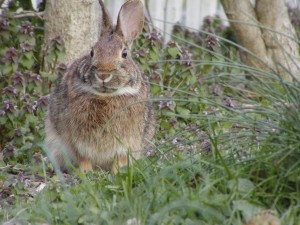
This little wildling let me take its picture this evening in between munching on the onion grass and ajuga. The wild bunnies here are pretty tame; I think they must sense the good bunny karma.
It’s getting to be the time of year when wild rabbits will be nesting. Here, they seem to have a knack for digging their nests in the most inappropriate places. Please do what you can to protect them by keeping your cat indoors and your dog and lawnmower away from their nests. Every year my dog manages to find at least one nest and, despite his innocence, mangle a wild baby. If you find a nest, the best thing to do is mark the spot, keep an eye on it, and leave them alone.
A wealth of information, including a link to a national list of wildlife rehabilitators, can be found here.
A new book, finally
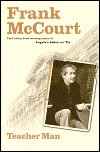 In case you haven’t noticed the change in my sidebar reading list, I’ve finally finished “Vanishing Acts”. It was a good book, but like most of Picoult’s novels, I was stalled halfway through reading it. I’m not sure what it is exactly, but I always lose interest for a while at the midpoint. It took me more than a month to read this one. Maybe it’s just that I’m busy doing other things and don’t have the time set aside to just sit and read like I normally like to. Reading for half an hour at a time may not work for her novels, maybe that’s why I lose interest. Anyway, it’s done and I’m happy to be starting a new book.
In case you haven’t noticed the change in my sidebar reading list, I’ve finally finished “Vanishing Acts”. It was a good book, but like most of Picoult’s novels, I was stalled halfway through reading it. I’m not sure what it is exactly, but I always lose interest for a while at the midpoint. It took me more than a month to read this one. Maybe it’s just that I’m busy doing other things and don’t have the time set aside to just sit and read like I normally like to. Reading for half an hour at a time may not work for her novels, maybe that’s why I lose interest. Anyway, it’s done and I’m happy to be starting a new book.
There is nothing quite like the excitement of picking up a book you know will be fun. I bought “Teacher Man” by Frank McCourt as a Christmas gift for my DH. He is not a reader, but enjoyed “Angela’s Ashes” and “Tis”, so I got him this one. So far, he’s ignored it, so I stole it last night and started reading during my lunch hour today.
I love McCourt’s sense of humor and the way he pokes fun at himself. I think my DH decided to read “Angela’s Ashes” because he saw me cracking up so often while reading it.
From the critics:
This final memoir in the trilogy that started with Angela’s Ashes and continued in ‘Tis focuses almost exclusively on McCourt’s 30-year teaching career in New York City’s public high schools, which began at McKee Vocational and Technical in 1958. His first day in class, a fight broke out and a sandwich was hurled in anger. McCourt immediately picked it up and ate it. On the second day of class, McCourt’s retort about the Irish and their sheep brought the wrath of the principal down on him. All McCourt wanted to do was teach, which wasn’t easy in the jumbled bureaucracy of the New York City school system. Pretty soon he realized the system wasn’t run by teachers but by sterile functionaries. “I was uncomfortable with the bureaucrats, the higher-ups, who had escaped classrooms only to turn and bother the occupants of those classrooms, teachers and students. I never wanted to fill out their forms, follow their guidelines, administer their examinations, tolerate their snooping, adjust myself to their programs and courses of study.” As McCourt matured in his job, he found ingenious ways to motivate the kids: have them write “excuse notes” from Adam and Eve to God; use parts of a pen to define parts of a sentence; use cookbook recipes to get the students to think creatively. A particularly warming and enlightening lesson concerns a class of black girls at Seward Park High School who felt slighted when they were not invited to see a performance of Hamlet, and how they taught McCourt never to have diminished expectations about any of his students. McCourt throws down the gauntlet on education, asserting that teaching is more than achieving high test scores. It’s about educating, about forming intellects, about getting people to think. McCourt’s many fans will of course love this book, but it also should be mandatory reading for every teacher in America. And it wouldn’t hurt some politicians to read it, too. (Nov. 15) Copyright 2005 Reed Business Information.
4/5/06 Mid-week bunny fix
To the shore
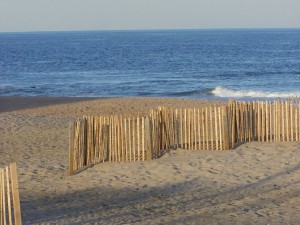 Many routes lead to water from where I live. Just standing here and looking out is entertaining. Gulls wheel across the horizon in winter. Loons and other diving ducks begin their courting within view of the breaking waves in spring before heading north. Buffleheads and oldsquaw populate the sheltered waters of the bay. Great blue herons stake out a protected pond despite the ice.
Many routes lead to water from where I live. Just standing here and looking out is entertaining. Gulls wheel across the horizon in winter. Loons and other diving ducks begin their courting within view of the breaking waves in spring before heading north. Buffleheads and oldsquaw populate the sheltered waters of the bay. Great blue herons stake out a protected pond despite the ice.
The cast of characters is predictable, the scenery unchanged in the sequence of seasons. The osprey and the plovers, the wading birds and the terns. Arriving, courting, nesting, and then departing once again. The buckeyes and monarchs filter through the dunes heading south with the summer sun. I’m left with the winter gulls wheeling in the ocean breeze; waiting for the next act.
Bunny self-expression
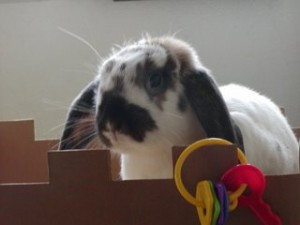 Freckles loves to throw stuff. She’s pretty unassuming as girl bunnies go, but when she figures that she’s been wronged, she lets you know about it by banging things. Of course, I nurture this habit by giving her lots of clunky things to make noise with. She has the usual bunny things like a set of baby keys and a rattle of sorts, but she much prefers to toss the small candy tin or the canning jar ring because the sound they make is so much more satisfying! She hops up on her shelf and throws everything off, one by one. The stuffed rabbit with extra long ears, the willow ball, the small wooden blocks; they all go. If that doesn’t get someone’s attention, she’ll hop down to the floor and continue to toss everything around. Mostly, she wants more hay or has decided it’s time for me to feed her (again!), but sometimes I think she does it just to see me come along and laugh at all the noise one little bunny can make.
Freckles loves to throw stuff. She’s pretty unassuming as girl bunnies go, but when she figures that she’s been wronged, she lets you know about it by banging things. Of course, I nurture this habit by giving her lots of clunky things to make noise with. She has the usual bunny things like a set of baby keys and a rattle of sorts, but she much prefers to toss the small candy tin or the canning jar ring because the sound they make is so much more satisfying! She hops up on her shelf and throws everything off, one by one. The stuffed rabbit with extra long ears, the willow ball, the small wooden blocks; they all go. If that doesn’t get someone’s attention, she’ll hop down to the floor and continue to toss everything around. Mostly, she wants more hay or has decided it’s time for me to feed her (again!), but sometimes I think she does it just to see me come along and laugh at all the noise one little bunny can make.
